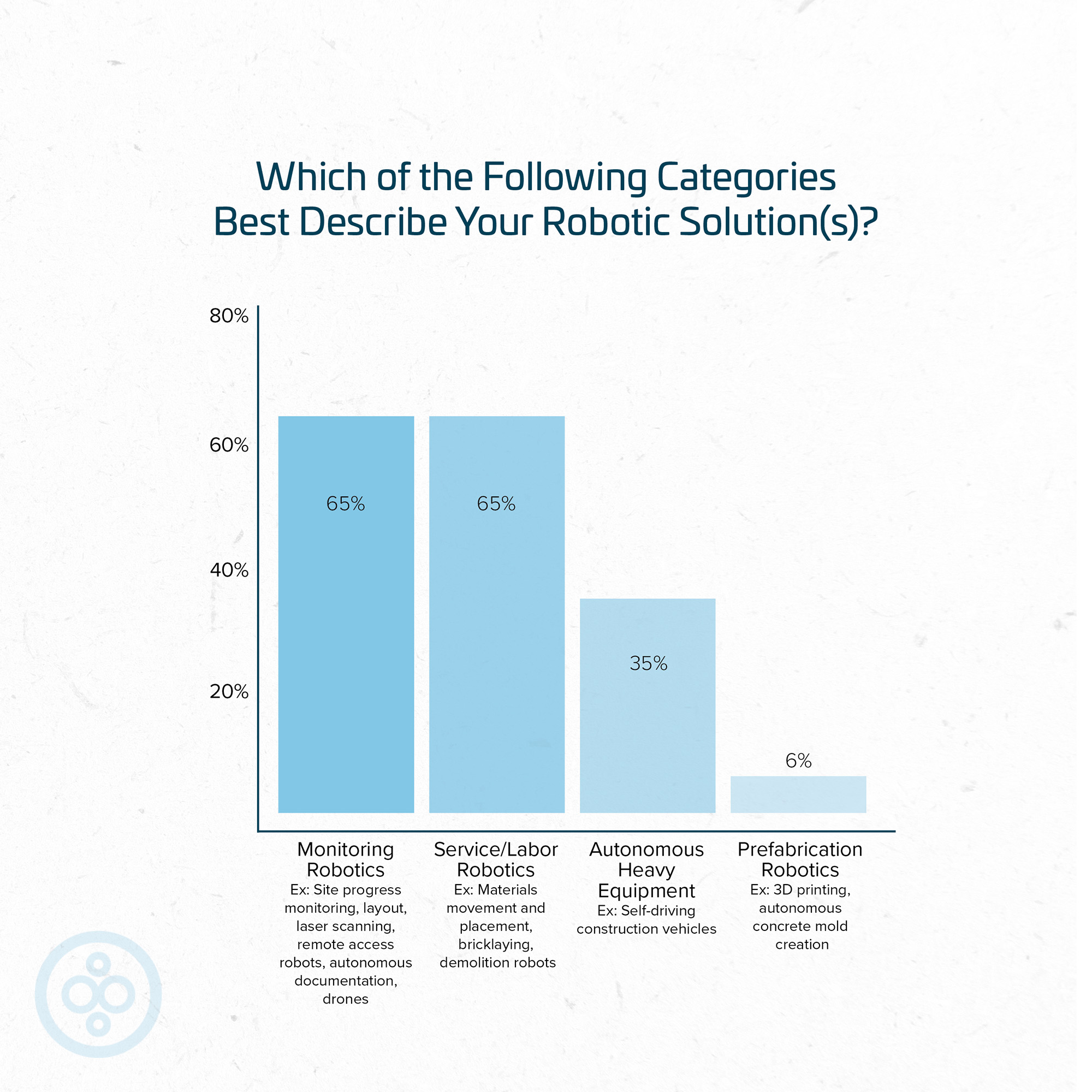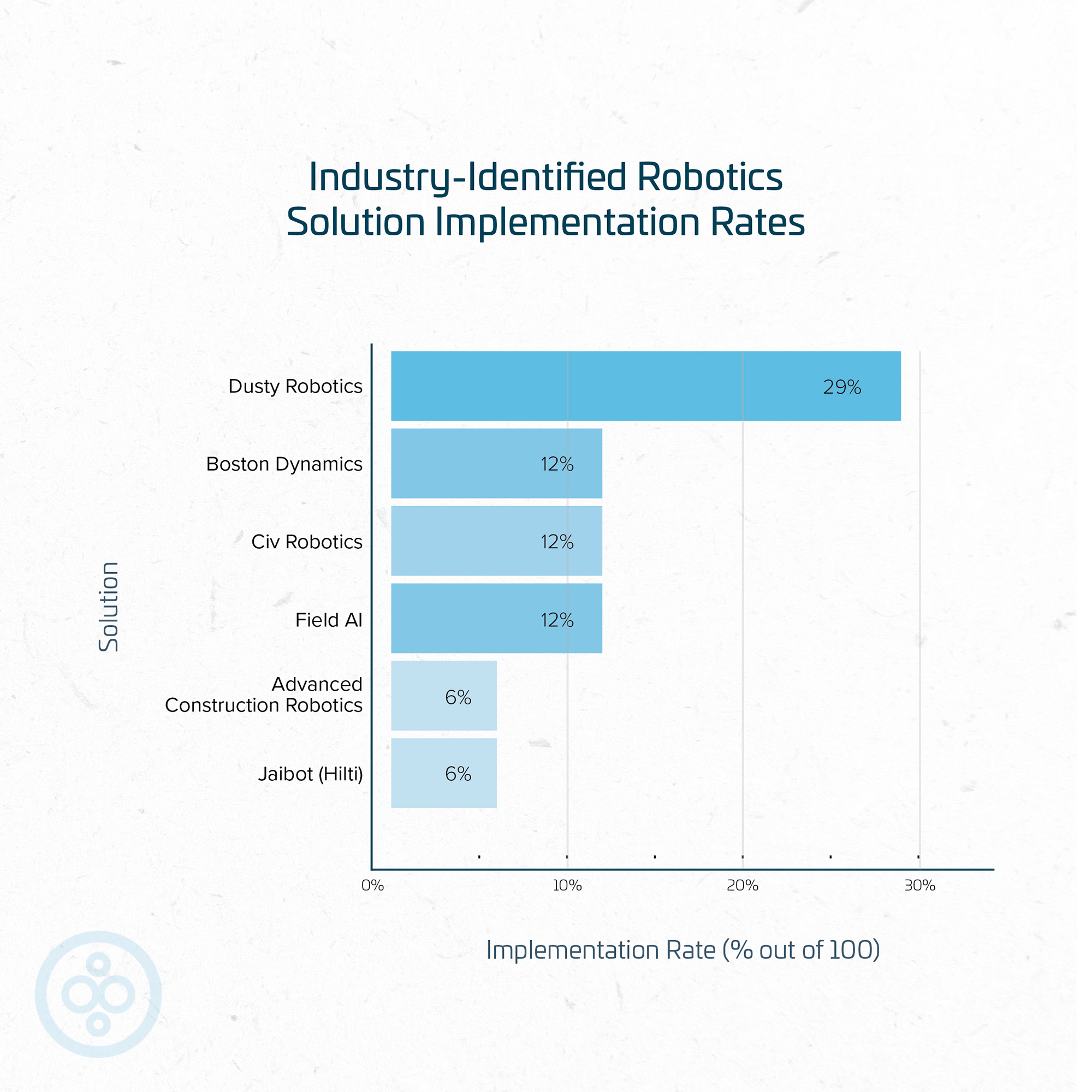BuiltWorlds, a member network dedicated to inspiring and advancing innovation in the AEC industry, has released its 2024 Tools, Equipment, and Robotics Benchmarking Report, an annual report that presents user survey data on category-specific technology adoption and usage. The report revealed that while the industry has been slow to adopt robotic solutions en masse, there has been considerable progress in certain areas, with one provider in particular seemingly pulling ahead as the preferred provider.
“The integration of advanced tools, equipment, and robotics represents a significant leap toward modernizing and streamlining operations within the AEC industry,” wrote BuiltWorlds Research Analyst Audrey Lynch, who authored the report. “This year, we saw the highest levels of adoption in monitoring robotics and service/labor robotics, two of the four main categories we've identified in construction robotics”
Nearly two-thirds of contractors surveyed, who cited use of robotics on jobsites, are either using monitoring and/or service/labor robotics. Thirty-five percent admitted to using autonomous heavy equipment, and a paltry 6% prefabrication robotics.

“There is a confluence of factors that are all working in tandem to drive increased utilization of robotics in the construction industry. The primary push forward is an increasingly prominent labor shortage in the industry,” said Tyler Sewall, Senior Director of Research for BuiltWorlds. He added, “Meanwhile, the typical barriers to adoption are slowly waning, leading to an environment more receptive to robotic solutions. The increased use of BIM, improved operability and accuracy, improved data collection and utilization, and an industry more culturally inclined to new technologies have all yielded material increases in the use of robotics.”
A Leading Provider in Dusty Robotics
Among the multiple robotic technology solutions providers named in the report, one provider stood out as both most implemented as well as highest rated: Dusty Robotics, a company that builds robots to help in laying out jobsites.
“Dusty Robotics consistently outperforms the industry average across all evaluated criteria, indicating its strong market position,” Lynch wrote. “With top ratings in adoption/utilization, ease of use, coordination with site activities, and data integration, the solution demonstrates its effectiveness and user-friendliness. It also excels in installation/performance speed and quality (tied with Civ Robotics), highlighting its reliability and efficiency.”

Why ‘Better Adoption’ Isn’t ‘Mass Adoption’
But while this year’s report shows wider scale adoption than years previous, particularly in the areas of service/labor and monitoring robotics, the industry has yet to embrace robotics into its mainstream.
“As much as the case for robotics continues to grow,” Sewall said, “there are, frankly, still so many reasons why robotics adoption isn't widespread, and may not be for a while.”
For one, most robotic solutions, he explained, require some variety of building model in order to operate.
“BIM, while well-adopted in some markets, is significantly underutilized in large portions of the industry.”

Another reason, Sewall shared, is that robotics, like any new technology, comes with a certain amount of risk—which is a problem in a traditionally risk averse industry.
“With layout robots, for instance, the second question is always, ‘Who owns the layout,’” he explained. “If the general contractor dictates how layout will be done, does that change the owner of the risk?”
Finally, and most obviously, is the cost.
“The up-front costs of robotic solutions are expensive,” Sewall said. “While larger companies can support these costs, many small- and mid-sized contractors simply cannot support any additional spend.”
Still, while there remain significant barriers to mainstream adoption of construction robotics, the data seems to indicate a slow acceptance and utilization of a technology that represents a massive boost to safety, efficiency, and productivity.
Related Stories
Codes and Standards | Mar 15, 2024
Technical brief addresses the impact of construction-generated moisture on commercial roofing systems
A new technical brief from SPRI, the trade association representing the manufacturers of single-ply roofing systems and related component materials, addresses construction-generated moisture and its impact on commercial roofing systems.
Sports and Recreational Facilities | Mar 14, 2024
First-of-its-kind sports and rehabilitation clinic combines training gym and healing spa
Parker Performance Institute in Frisco, Texas, is billed as a first-of-its-kind sports and rehabilitation clinic where students, specialized clinicians, and chiropractic professionals apply neuroscience to physical rehabilitation.
Market Data | Mar 14, 2024
Download BD+C's March 2024 Market Intelligence Report
U.S. construction spending on buildings-related work rose 1.4% in January, but project teams continue to face headwinds related to inflation, interest rates, and supply chain issues, according to Building Design+Construction's March 2024 Market Intelligence Report (free PDF download).
Apartments | Mar 13, 2024
A landscaped canyon runs through this luxury apartment development in Denver
Set to open in April, One River North is a 16-story, 187-unit luxury apartment building with private, open-air terraces located in Denver’s RiNo arts district. Biophilic design plays a central role throughout the building, allowing residents to connect with nature and providing a distinctive living experience.
Affordable Housing | Mar 12, 2024
An all-electric affordable housing project in Southern California offers 48 apartments plus community spaces
In Santa Monica, Calif., Brunson Terrace is an all-electric, 100% affordable housing project that’s over eight times more energy efficient than similar buildings, according to architect Brooks + Scarpa. Located across the street from Santa Monica College, the net zero building has been certified LEED Platinum.
Contractors | Mar 12, 2024
The average U.S. contractor has 8.1 months worth of construction work in the pipeline, as of February 2024
Associated Builders and Contractors reported that its Construction Backlog Indicator declined to 8.1 months in February, according to an ABC member survey conducted Feb. 20 to March 5. The reading is down 1.1 months from February 2023.
Museums | Mar 11, 2024
Nebraska’s Joslyn Art Museum to reopen this summer with new Snøhetta-designed pavilion
In Omaha, Neb., the Joslyn Art Museum, which displays art from ancient times to the present, has announced it will reopen on September 10, following the completion of its new 42,000-sf Rhonda & Howard Hawks Pavilion. Designed in collaboration with Snøhetta and Alley Poyner Macchietto Architecture, the Hawks Pavilion is part of a museum overhaul that will expand the gallery space by more than 40%.
Affordable Housing | Mar 11, 2024
Los Angeles’s streamlined approval policies leading to boom in affordable housing plans
Since December 2022, Los Angeles’s planning department has received plans for more than 13,770 affordable units. The number of units put in the approval pipeline in roughly one year is just below the total number of affordable units approved in Los Angeles in 2020, 2021, and 2022 combined.
BIM and Information Technology | Mar 11, 2024
BIM at LOD400: Why Level of Development 400 matters for design and virtual construction
As construction projects grow more complex, producing a building information model at Level of Development 400 (LOD400) can accelerate schedules, increase savings, and reduce risk, writes Stephen E. Blumenbaum, PE, SE, Walter P Moore's Director of Construction Engineering.
AEC Tech | Mar 9, 2024
9 steps for implementing digital transformation in your AEC business
Regardless of a businesses size and type, digital solutions like workflow automation software, AI-based analytics, and integrations can significantly enhance efficiency, productivity, and competitiveness.

















